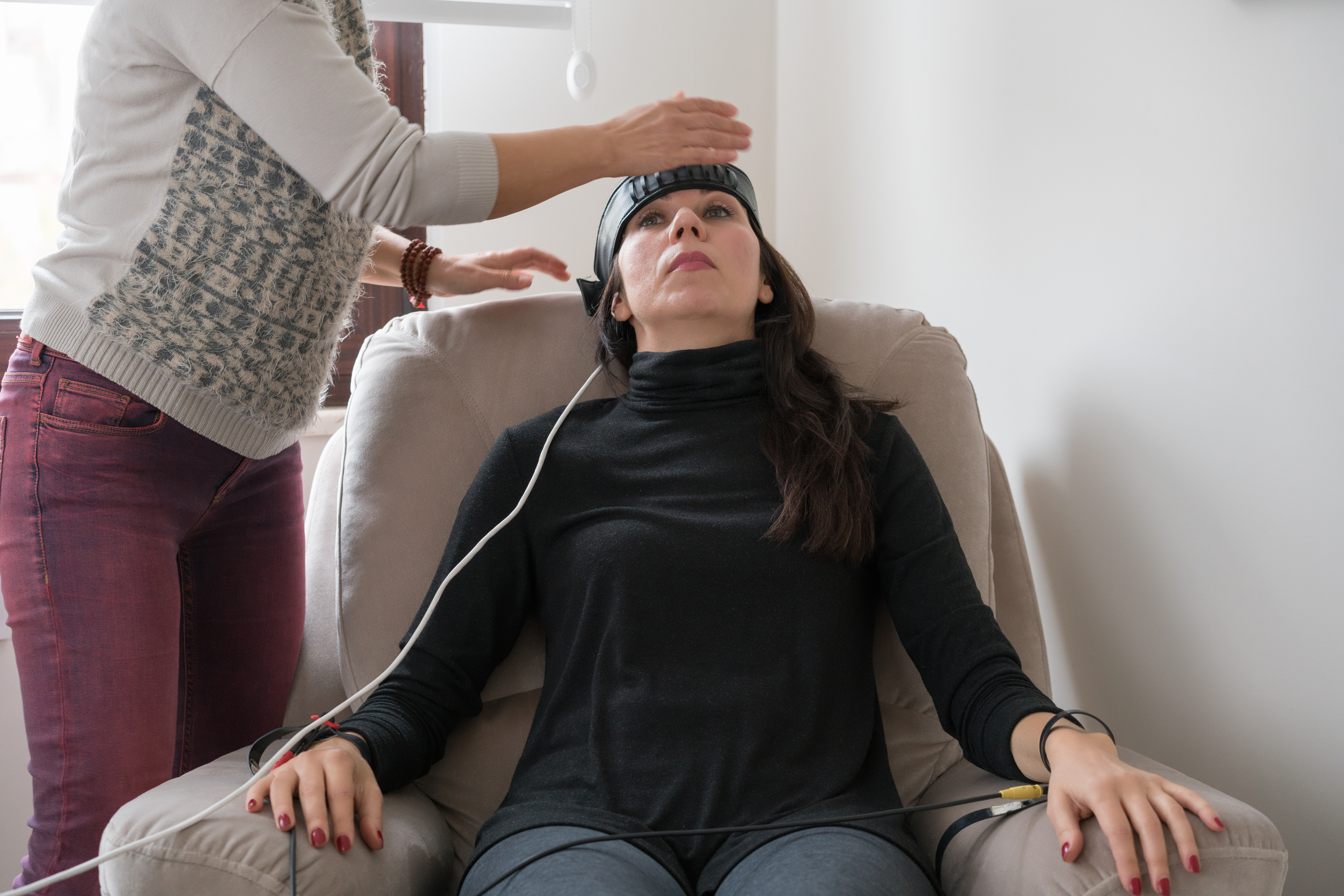What is a Biofeedback Session?
Get answers to the following questions: What is biofeedback? How does it work? What does a session look like?
What is Biofeedback?
Biofeedback uses sensors to obtain awareness of one’s physiological activities. It teaches people how to manage and gain control of certain involuntary body functions.1
What is biofeedback? Biofeedback is a mind-body therapy that can help with physical and emotional health. It is a non-invasive, non-drug treatment where patients learn to manage involuntary body processes. It is acceptable for persons who choose not to use medications or are unable to use them. During biofeedback, a therapist will use painless sensors to measure specific body systems. The therapist then proposes ways to promote physiologic changes based on the feedback.
Contact Profound Treatment to Learn More
Our team is standing by to discuss treatment options with you. Your call is completely confidential and no obligation is required.
Is Biofeedback Therapy Effective?
What is biofeedback and is it effective? Biofeedback is an effective treatment for various health issues. Studies have also shown it may help ease symptoms of Raynaud disease, ADHD, and autism in children. When combined with a fiber-rich diet, biofeedback may help relieve abdominal pain.

What Kinds of Medical Conditions Can Biofeedback Therapy Help Treat?
What is biofeedback used for? Biofeedback treats both physical and mental conditions. These conditions are detailed below.
Stress and Anxiety
One of the most common applications of biofeedback is anxiety relief. Biofeedback brings awareness to your body’s responses when stressed or anxious. With this information, you may be able to learn how to control your anxiety.
Headaches
Stress and muscle tension can trigger headaches and migraines in humans. Using biofeedback therapy can help relieve stress and reduce the severity of headaches. This type of therapy is very effective, especially when combined with medication.
Chronic Pain
Biofeedback therapy can serve as an alternative pain reduction mechanism. It helps to relax tight muscles and reduce painful conditions in children and adults.
Gastrointestinal Problems
Biofeedback is a good treatment for most gastrointestinal disorders like constipation. Thermal biofeedback can help to relax the pelvic floor muscles during defecation.
Urinary Incontinence
Kids with trouble controlling the urge to use the bathroom may do so with biofeedback. Biofeedback can help women strengthen their pelvic floor muscles and bladder.
Pelvic Floor Dysfunction
Biofeedback can be used as a pelvic floor exercise for women who suffer from pelvic dysfunctions. It helps strengthen the muscles used to control the opening and closing of the bowels. A small device provides visual and auditory stimuli and feedback during biofeedback sessions.
High Blood Pressure
Biofeedback reduces blood pressure by lowering stress levels and controlling blood pressure. Techniques like muscle relaxation and control of breathing may lower high blood pressure.
How Does Biofeedback Therapy Work?
The big question is this: What is biofeedback and how does it work? A therapist uses different methods depending on your involuntary body functions and responses. These methods include pulse, blood pressure, skin temperature, breathing, muscle tension, and carbon dioxide production.2
Pulse
This biofeedback method measures the pulse and how the heart rate varies. Sensors on the fingers or earlobes help to measure pulse and blood volume changes.
Blood Pressure
Therapists place electrodes on your skin during a biofeedback session. The electrode sends signals to a screen to display your heart, breaths, and blood pressure.
Skin Temperature
Sensors on the fingers or feet check skin temperature based on blood flow. It can aid in the treatment of anxiety disorders and headaches.
Breathing
Bands are wrapped around your abdomen and chest to watch your breathing and detect over-breathing. Biofeedback therapy, like relaxing music, control of breathing can help regulate breathing.
Muscle Tension
Measurement of muscle tension takes place during this therapy session. Sensors implanted in skeletal muscles detect electrical activity. It helps treat headaches, back pain, and anxiety.
The Amount of Carbon dioxide That You Breathe Out
This is also known as capnometry. This method measures carbon dioxide to detect over-breathing. Over breathing is a common symptom of anxiety. Your therapist may come up with appropriate breathing exercises after capnometry.
What are the Types of Biofeedback Therapy?
While answering the question, “What is biofeedback?” You should also know the types of biofeedback therapy. There are several types of biofeedback therapy. But your health and goal determine the best for you. The three most common types of biofeedback therapy include electromyography, thermal feedback, and an electroencephalogram.3
Electromyography (EMG)
An electromyography (EMG) test assesses muscles and the nerve cells that control them. During an EMG, your muscles contract due to signals sent to your motor neurons. These signals convert into graphs, sounds, or numerical values.
Thermal Feedback
Thermal feedback assesses a person by measuring their body and skin temperature. It requires that patients wear sensors that detect blood flow to the skin. This therapy helps detect abnormal temperatures during stress.
Electroencephalogram(EEG)
An EEG test uses electrodes on the scalp to assess and measure electrical activity in the brain. Abnormalities in the brain show up during the test to help you alter feedback and control body parts.
What is a Typical Biofeedback Session Like?
Another big question that gets asked along with “What is biofeedback” is what does a session look like? The majority of sessions happen in the office of a trained biofeedback therapist. It also involves the use of computer devices. A regular session involves the steps detailed below.
Introduction
Upon commencement, the therapist asks about your symptoms, medical history, and current medications. The doctor explains and discusses any discomfort that may occur during the process.
Set-Up and Therapy
After a proper introduction, the therapist sets up the machines. He or she then attaches electrodes or other sensors on the skin within a particular body area. Feedback from sensors displays on screens or speakers.
Feedback
Feedback transmits as an image on the computer screen, a beeping sound, or a flashing light. Feedback from the sensors identifies problematic involuntary physical responses.
Strategies and Techniques
After feedback, therapists create relaxation techniques that help control involuntary responses. For example, breathing exercises help slow an increased heart rate or respiration. After these strategies, further feedback appears as the body responds to treatment.
What to Expect During a Biofeedback Therapy Session
What is biofeedback and what should you expect? A therapist will use painless sensors to measure certain involuntary body functions. You will see the results on a screen and then experiment with different ways to change them.
How Long do Sessions Last?
What is biofeedback therapy’s duration? Each therapy session is to last less than one hour. The number, length, and type of therapy sessions depend on your condition and response to treatment.4
How Many Sessions Will I Need?
Your condition determines the number of sessions, but most people see changes in eight to ten sessions. Treatment of headache, incontinence, and Raynaud disease requires at least ten weekly sessions. Conditions like high blood pressure may need up to twenty sessions before improvement.

Benefits of Biofeedback
People who ask the question, “What is biofeedback?” are often curious about its benefits. Biofeedback helps individuals who suffer from migraines, urinary incontinence, or pelvic floor dysfunction. When considering biofeedback therapy, know that:
- It is non-invasive
- It can complement other treatments
- It can put you in control of your feelings
Who is Qualified to Do Biofeedback Therapy?
Only a biofeedback therapist can perform biofeedback. Biofeedback therapists are usually medical providers that have the needed biofeedback certification.
Does Biofeedback Therapy Have Risks?
There has been no report of adverse side effects or known risks of biofeedback. However, biofeedback may not be for everyone. Consult your primary care provider to discuss and learn which treatment works best.
How Much Does a Biofeedback Session Cost?
What is biofeedback cost? Fees for biofeedback vary depending on the therapist’s training, experience, and qualification. Average costs for biofeedback often range from $35 to $85 per session.
Does Insurance Cover Biofeedback?
What is biofeedback coverage like? For a long time, biofeedback therapy was not covered by insurance, but this is changing. Although not all insurance companies cover it, others have become open to the idea. To be safe, you should call your insurance to inquire about biofeedback coverage.







